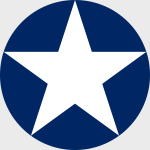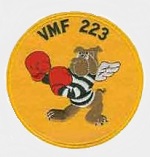Hobby Master HA8901 USMC Grumman F4F-4 Wildcat Fighter - Marion Carl, "White 2", VMF-223 "Bulldogs", Guadalcanal, September 1942 (1:48 Scale)
"Why should we have a navy at all? There are no enemies for it to fight except apparently the Army Air Force."
- General Carl Spaatz, Commander of the US 8th Army Air Force, after WWII
 The Grumman F4F Wildcat was the standard carrier-based fighter of the United States Navy for the first year and a half of World War II. An improved version built by General Motors (the General Motors FM Wildcat) remained in service throughout the war, on escort carriers where newer, larger and heavier fighters could not be used.
The Grumman F4F Wildcat was the standard carrier-based fighter of the United States Navy for the first year and a half of World War II. An improved version built by General Motors (the General Motors FM Wildcat) remained in service throughout the war, on escort carriers where newer, larger and heavier fighters could not be used.
The Wildcat was outperformed by the Mitsubishi Zero, its major opponent in the Pacific war, but held its own by absorbing far more damage and wielding more firepower. With heavy armor and self-sealing fuel tanks, the Grumman airframe could survive far more than its lightweight, unarmored Japanese rival.
The original Grumman F4F-1 design was a biplane, which when proving inferior to rival designs was recast as the monoplane F4F-2. This was still not competitive with the Brewster F2A Buffalo which won initial US Navy orders, but when the F4F was fitted with a more powerful engine, the Pratt & Whitney Twin Wasp, it showed its true merits and became the F4F-3. US Navy orders followed as did some (with Wright Cyclone engines) from France; these ended up with the Royal Navy's Fleet Air Arm after the fall of France. In British service initially these were known as the Martlet I, but not all Martlets would be to the exact same specifications as US Navy aircraft. The F4F-3A would enter service as the Martlet III(B), the FM-1 as the Martlet V, and the FM-2 as the Martlet VI. The name Wildcat was still commonly used for these aircraft inspite of the official name change.
A new version, the F4F-4, entered service in 1942 with six guns and folding wings, allowing more to be crammed on a carrier; this was the definitive version and the one that saw the most combat service in the early war years including the Battle of Midway.
Grumman production ceased in early 1943 to make way for the newer F6F Hellcat, but General Motors continued producing them for both US Navy and Fleet Air Arm use, as larger fighters such as the Hellcat and the Vought F4U Corsair were too large for use on escort carriers. At first they produced the identical FM-1 model but then switched to the improved FM-2 (based on Grumman's F4F-8 prototype) with a more powerful engine and a taller tail to cope with the torque. In all, 7,251 Wildcats were built.
All versions of the Wildcat used hand-cranked landing gear with a relatively narrow track, making landing accidents where the landing gear were not fully locked into place distressingly common.
Pictured here is a 1:48 scale USMC Grumman F4F-4 Wildcat fighter that was piloted by Marion Carl, who was attached to VMF-223 "Bulldogs", then deployed to Guadalcanal during September 1942.
Sold Out!
Dimensions:
Wingspan: 9-1/2-inches
Length: 7-1/4-inches
Release Date: October 2018
 Historical Account: "Cactus Air Force" - Cactus Air Force refers to the ensemble of Allied air power assigned to the island of Guadalcanal from August 1942 until December 1942 during the early stages of the Guadalcanal Campaign, particularly those operating from Henderson Field. After December, the official name of the unit became Aircraft, Solomons (AirSols), but Cactus Air Force was still used frequently to refer to the organization. The term "Cactus" comes from the Allied code name for the island. In April 1943, the organization was redesignated as AirSols.
Historical Account: "Cactus Air Force" - Cactus Air Force refers to the ensemble of Allied air power assigned to the island of Guadalcanal from August 1942 until December 1942 during the early stages of the Guadalcanal Campaign, particularly those operating from Henderson Field. After December, the official name of the unit became Aircraft, Solomons (AirSols), but Cactus Air Force was still used frequently to refer to the organization. The term "Cactus" comes from the Allied code name for the island. In April 1943, the organization was redesignated as AirSols.
Marine Fighter Squadron 223 (VMF-223) was commissioned on May 1st, 1942 at Marine Corps Air Station Ewa, Oahu, Hawaii. The "Bulldogs" first operational aircraft was the Brewster F2A Buffalo. They left Hawaii for combat equipped with the Grumman F4F Wildcat. VMA-223 became the first fighter squadron committed to combat during the Battle of Guadalcanal when they landed at Henderson Field on August 20th, 1942. Upon arriving, the squadron became part of the Cactus Air Force and for the next two months slugged it out with Japanese pilots, based out of Rabaul, for control of the skies over Guadalcanal. VMF-223 left the island on October 16th, 1942 having accounted for 110-1/2 enemy aircraft shot down including that of Japanese ace Junichi Sasai. The two leading aces in the squadron were the commanding officer, Major John L. Smith, with nineteen confirmed shoot downs and Marion E. Carl who was credited with sixteen. Smith was to be awarded the Medal of Honor for heroism and Captain Carl would win the first of his two Navy Crosses for these actions. These victories would come at the cost of six pilots killed and six wounded, and only eight Wildcats still operational.






![USAF Fairchild Republic A-10C Thunderbolt II Ground Attack Aircraft - "Tiger Shark," 74th Fighter Squadron "Flying Tigers", 23rd Wing, 2011 [Low-Vis Scheme] (1:72 Scale)](http://cdn4.volusion.store/qh9e9-jdqv9/v/vspfiles/photos/HA1321-1.jpg?v-cache=1740197136)
